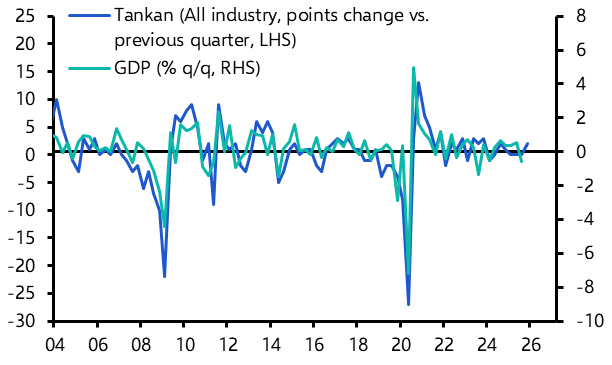What’s behind the slowdown in the global economy in recent months? It’s a question we’re often asked by clients – and one to which there is no simple answer.
Part of the problem is that it’s often difficult to isolate the causes of economic downturns (and, for that matter, upturns) in real time. It’s also the case that the recent weakness in the data may prove to be a flash in the pan. After all, as I’ll discuss later, some of the headwinds weighing on activity are likely to prove temporary. As they ease, the drag on growth should diminish. Meanwhile, the flash PMIs for February, released last week, contained some better news (German services) alongside further gloom (German and Japanese industry).
Nonetheless, stepping back, it remains the case that a broad swathe of survey data suggest that the global economy slowed in the final quarter of 2018 and the early months of 2019. (See Chart 1.) So what’s going on?
Chart 1: Indicators of Economic Activity (Standardised, LR Avg = 100)

Interestingly, while the threat of a global trade war remains a cloud on the horizon, we don’t think it has been a major factor in the recent slowdown. Instead, three things seem to be behind the softening in the global economy.
First, while the activity data have weakened in most countries in recent months, this has been most pronounced in the euro-zone. There are several issues at play here. We estimate that up to half of the slowdown over the second half of 2018 was due to the disruption caused to vehicle production from new emissions tests. This should prove temporary. The remainder appears to be a combination of weaker household spending (which should reverse as inflation eases this year), and a drop in investment and exports (which may prove longer-lasting).
The second explanation is weaker growth in China. Admittedly, some parts of the Chinese economy appear to be performing well. In particular, the construction data that we follow suggest that the sector has been relatively strong in recent months. But there are pockets of weakness (for example auto sales) and the import data suggest that domestic demand more generally is softening. The most likely explanation is that this reflects the effects of past policy tightening. As more recent policy stimulus starts to feed through, we expect China’s economy to stabilise over the second half of this year.
The third explanation is that investment in several countries has weakened. Among the G7 economies, residential investment has slowed everywhere except Germany. This probably reflects the effects of tightening monetary conditions (after all, housing is one the most interest rate-sensitive sectors of the economy). Meanwhile, non-residential investment growth has dropped in the UK, France and Italy. (See Chart 2.) This is likely to reflect concerns about the political outlook in these countries, which appears to have caused firms to scale back their investment plans.
Chart 2: Non-Residential Investment (% y/y)

One final point to note is that all of these headwinds are likely to be amplified by feedback loops within and between economies. For example, concerns about the growth outlook triggered the market sell-off in the final few months of last year, which caused financial conditions to tighten and thus added to the drag on growth. More fundamentally, the 2000s saw a big shift towards greater global integration, the result of which is that weakness in one region can now spread more quickly and easily to others.
All of this leads to the rather unsatisfactory conclusion that there are several factors behind the apparent slowdown in the global economy in recent months. As it happens, that’s typical of most downturns. The 2008-09 recession was unusual in several respects, but one was that it had a single big cause – debt and housing. In contrast, it’s more common for economic slowdowns and recessions to be caused by multiple factors that interact with each other to produce a downturn that’s greater than the sum of its parts. It shouldn’t therefore be a surprise if the next global downturn resembles something more like the historic norm – much less severe than the crisis of 2008-09, but with its roots in several different areas.
In case you missed it:
(Requires login)
- Our Chief EM Economist, William Jackson, dissects plans for pension reform in Brazil.
- Our China team assesses the risks from rising external debt.
- Our Chief UK Economist, Paul Dales, looks at how fiscal and monetary policy might respond in the event of a “no deal” Brexit.




